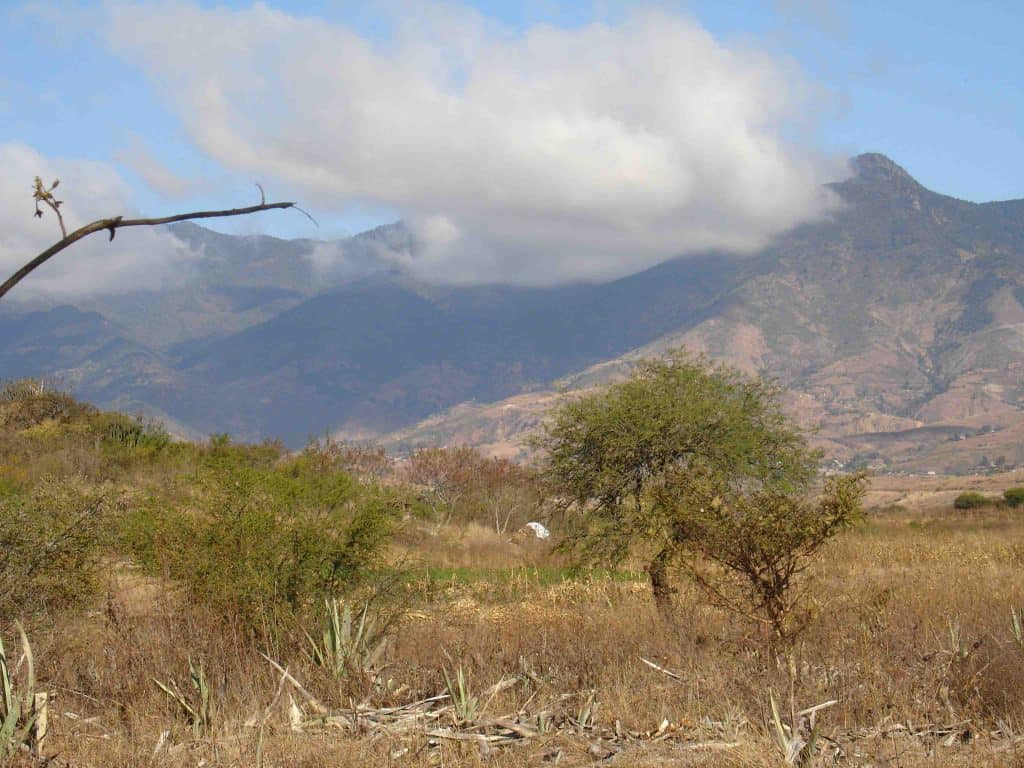
I once swore I would never ever drive in Mexico. I think I also swore once that I would never drink more than 3 mezcals in one day.
The thing is, driving here in Oaxaca is rife with all sorts of potential disasters; cars that speed through intersections, topes (speed bumps) and more topes that appear with no warning on highways, roads that just disappear into dirt, donkeys, goats, and sundry other animals that wander onto country roads. None of this is to ignore the lack of directional signage, the signs that lead to wrong turns, and the inevitable necessity of stopping and asking directions. Classic Oaxaca car moment: “Ok, we’re lost. Stop the car and let’s wait for the guy on the donkey to catch up with us so that we can ask him how to get back to Oaxaca.”
So of course I ended up having to be the driver one morning at 4AM as we left Oaxaca in the pitch black for a maguey cut in Chichicapam. I drove because it turned out José Luis isn’t a morning person, and even worse for a first time Oaxaca driver like me, he’s a terrible navigator. But driving through the valley as the sun rose was unbelievably beautiful, the sky turning a light purple, then orange and gold, casting shadows from the clouds over the rocky mountains. It’s one of those moments that makes you wonder why you don’t witness the sunrise more often.
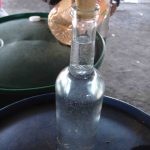
We arrived early despite the wrong turns and had an hour before we were scheduled to head out for the cut and so we decided to visit Don Pedro and pick up more of his mezcal. I was skeptical that you could do that at 6:30 in the morning, but there he was and there we were, having to take the obligatory taste before having our bottles filled. Side note – a great thing about going straight to a palenque to buy mezcal is being able to fill or refill your own bottles or plastic jugs. A shot of mezcal in the morning is one helluva way to start the day.
And so onto the cut, following Alfonso’s pickup truck, loaded with the six harvesters, dogs running along side. We arrived at the communal growing field, where residents of the pueblo share land, farming side by side and creating a diverse growing field of corn, maguey, onions, greens, and sundry other plant rotations that keep the soil healthy. This system of communal properties is being slowly eroded as land is sold due to encroaching poverty, the long term impact of NAFTA, and people leaving the pueblos in search of better economic prospects. As more land is sold, more land is consolidated which leads to a greater prevalence of mono-cropping with its own deleterious effects. Since cultivated maguey takes 5-7 years to mature multiple areas are farmed to allow for a continual harvest. As pieces of land are removed from that rotation it gets more difficult to produce truly artisanal mezcal.
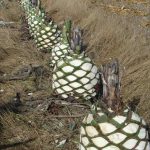
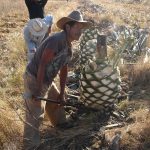
We parked the cars and made out way to a field of espadins whose spiky leaves had already been shaved from the piñas on a previous day. They were going to be cutting about 80-90 for a roast. They harvest about every two weeks to keep the process constantly going – roast, ferment, distill. All done by hand and in cutting maguey that means dealing with a piña that is about 2-3 feet high and as big around, each one weighing about a hundred pounds. Machetes, a sledgehammer, a shovel like device – these are the tools of the trade: After watching the back breaking work for almost 2 hours I will never complain about the cost of an artisanal bottle of mezcal.

Alfonso then walked José Luis and I toward the river that snakes through the fields. He pointed out other varieties of maguey in other fields, showing us the differences in the shapes of the leaves, the height of the stalks, mature vs. young, and discussing the factors that influence the flavor of the magueys (variety, water, etc.) The river was shallow and crystal clear, lined with shade trees and a narrow bank. The three of us stood in silence before turning back. It was a gorgeous walk, with a gorgeous blue sky punctuated by puffy white clouds and whenever I would need to “escape to my happy place” in times of stress or misery, this will definitely be at the top of the list.
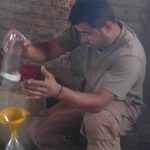
We returned to the Palenque, moved a fermented barrel of maguey to the stills, and then, of course, began tasting more mezcal. One of the great things about working with a palenquero is that he’ll show you the blending process. It’s incredibly elemental, essentially him mixing a cocktail of different distillations according to a sensory algorithm in his head. When you taste the raw materials and then the blends, the magic of mezcal truly makes sense: It’s only then that you truly comprehend the impact of terroir and the palenquero. Note, it was not yet noon.
Finally, we decided to go get some food at the comedor, bottle of special blend mezcal in hand.So we had a long lunch over fried fish. Two bottles of mezcal on the table, the owner of the comedor joining us, and me sitting back and listening to the conversation flow before I said much of anything (shut up and listen is a great practice in situations like this.) I also knew I was being tested, or more to the point, they were also trying to get a read of me, and also see just how much mezcal I could drink. It was the classic keeping up with the boys moment.
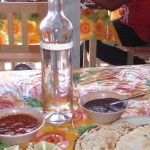
I did my best not to embarrass myself and finally joined in the conversation when they were discussing how to better market the artisanal products in Chichicapam. I spoke of my desire to put education about mezcal first and foremost in any business I would develop around the spirit. I delved into the use of the words organic, natural, artisanal, prompting a huge debate. Let’s just say, they don’t think much of the word organic and think it’s bullshit given everything that they do is completely natural, traditional, and artisanal. In fact, certifying organic would mean having to move to a more mechanized and industrialized method (oh the irony!)
José Luis tried to keep me from saying anything that could be construed as offensive (machismo in the mezcal) world reminded me that some words were stronger than others (no manches vs. no mames) and to tread lightly. It was three hours of fascinating debate about perspectives on artisanal products, on the impact of NAFTA on farming communities in Oaxaca, the immigration flow north and how to educate the US market on mezcal, and at the end, it was all-good and we headed back to the Palenque for more mezcal, including an oh so special Conejo – like a Pechuga, only with rabbit. One word – wow. Without a doubt it was the smoothest, most delicate, mezcal I have ever had.
And I like to think that by sharing this conejo with me, it somehow meant I had passed the test.
The drive home was amazing, as my iPod spat out a random mix of Ella Fitzgerald, Neko Case, and Nirvana. The day washed over us, its utter perfection, the joy of a friend’s presence, and of course that warm glow of mezcal coursing through our veins.

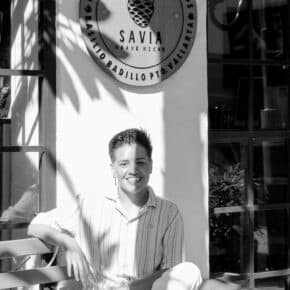

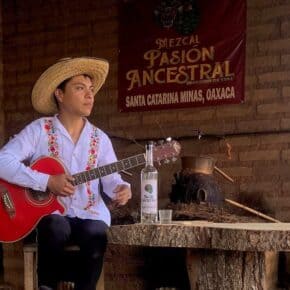









Leave a Comment